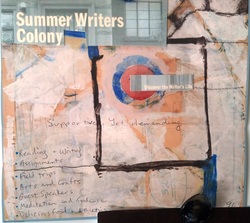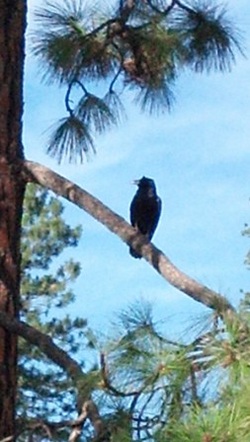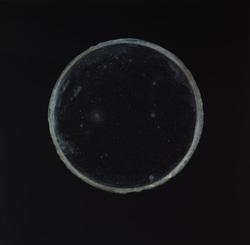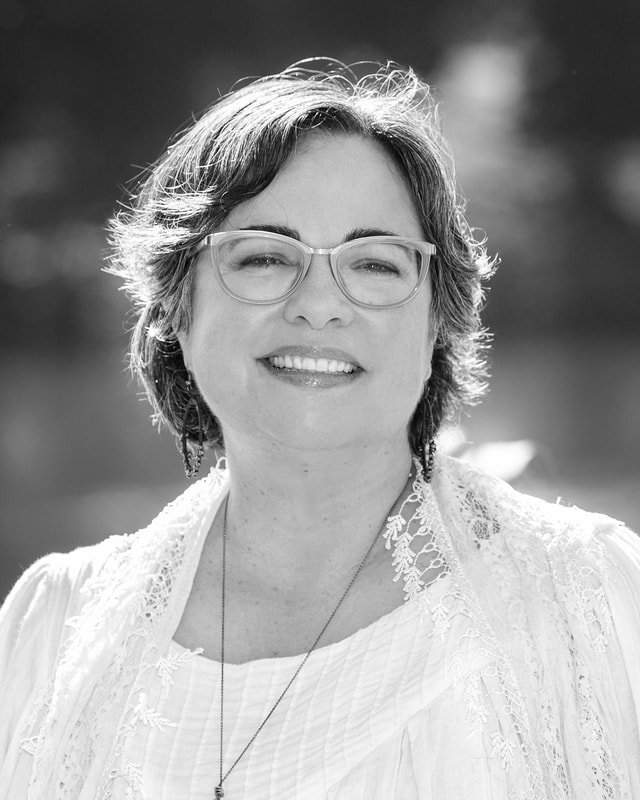 Greetings from my Summer Writing Colony. I love it here, and I am getting stuff done and surprising myself. Won’t you join me? It’s free, and you can attend from exactly where you are. It doesn’t matter whether your job or family can spare you—you can join! Let me explain. There I was, salivating over writing workshops, conferences, and colonies listed in Poets and Writers and The Writer’s Chronicle. But this summer I don’t really have cash to attend, nor can I get away from family responsibilities, or add another flight onto my schedule. Then I saw a line from one of Gretchen Rubin’s Happiness Project calendars: “Put yourself in Creativity Boot Camp: Tackle a project in an intense, concentrated way, and push yourself to accomplish a lot in a short amount of time.” I returned to my magazines with new eyes. If I could design my own retreat, what exactly would it look like? Soon I was cutting and pasting ads until I had created my ideal Summer Writing Colony poster. “Weekly Intensives,” I promised myself, in an atmosphere that would be “Supportive, Yet Demanding.” Most of my energy in this colony session will go into reading, writing, and completing supportive, yet demanding weekly assignments. But I will also experience literary field trips, arts and crafts sessions, lectures from brilliant guest speakers, and daily meditation and soul guidance. And this place happens to feature delicious food and fun physical workouts. It’s kind of a spa retreat and writing boot camp all rolled into one. At home. Over the next six or seven weeks I’ll break down the menu so you can implement YOUR OWN writing colony schedule as an honorary member. Your assignment for this week: Buy or borrow a writing magazine that inspires you. Read your writing source this week and take notes about what you want to do on your next four to six weekly intensives. See if you can do some cutting, taping, and designs to create your OWN poster of intention for this summer—or make one online on Pinterest. What do you want to accomplish this summer? What does your ideal retreat look like? Let me know! Go to Part 2  Floods of information and inspiration poured forth from the AWP conference in Seattle. Thousands and thousands of writers congregated with editors, publishers, poets, teachers, and students. I recognized my tribe. In packed rooms I scribbled notes as speakers addressed subtleties in spiritual writing, researching historical novels, nature essays, regional poetry. One night I heard Eva Saulitis, a marine biologist, teacher, writer, and poet (and beekeeper), describe long, cold months observing orca whales. She described how the boredom, the waiting, the emptiness were aspects of imagination, precursors of her work. The work, she said, came from the intersection of “data collection and awe.” I arrived home with so much to think about. My craft and direction were reconfirmed. I found leads to publish work. I made friends, growing a community that suddenly spans the globe. I heard new models of writing and carted home pages of notes toward the New Book, skills in Twitter, goals for blogging, and a writing schedule to try out. And enough literary magazines to pull my shoulder out of whack. It was an overabundance. I swam in it for three weeks after the conference. * * * Neighborhood crows flap heavier these days because their beaks are filled with sticks. They are building nests, of course, as I build scaffolding for my new book. “Pairs function as highly synchronized teams, building large, stick-based nests, carefully lining them with fine rootlets or hair.” (Marzluff and Angell, In the Company of Crows and Ravens.) An initial web of ladders and planks give workers safe access to transform all parts of a structure. For a book, scaffolding might include an outline, a timeline, a narrative arc plotted on a whiteboard or paper. I also build a schedule on paper and in Google. The schedule must include walks, library research, fieldwork, and snacks of music, books, drawing, museum visits. “Crows take a great deal of time choosing the sticks they want to use in the construction of their nests.” (Haupt, Crow Planet: Essential Wisdom From the Urban Wilderness.) The scaffold also serves to protects the act of writing itself, because life is so full with family, other work, events, friends. I keep re-learning that limits must be set. “The crow’s nest is a remarkably intricate piece of work, belying both the rough exterior of the structure and the bulkiness of its creators.” (Haupt) At this time, it's better for me to dwell inside the book for several days or weeks at a time, listening to echoes and characters, without forced interruptions to broadcast content. See you in a few weeks. This week I'll join more than 12,000 other writers and editors, professors, agents and students at an extravaganza called AWP. It's my first one.
I'll bring a small rolling bag and a black daypack to carry snacks, my itinerary, aspirin, some old sweaters, and empty journals. But that's my toolkit, not baggage. The things I will NOT be lugging around (and I was certain that I would):
There is, in fact, very little on the horizon. As though the Universe is sweeping everything from my path, with Infinite Love, and telling me to get to work on the art right under my nose. I feel so untethered. Tomorrow I head north, and plan to go in a state of quiescent listening!  I confess I have been stymied this past week as to what to write. None of my wedding topics seemed right, and I didn’t want to pull out a rerun yet. But for the first time I was blocked. Why? Perhaps it is because I am suffering from a terrible case of In-between-ness. After thirteen months of steady work, I have completed one thing, The Book (about weddings). And not yet started the next thing. Soon the big push to publicize The Book will commence, but right now it is completely out of my hands. No-one from the publisher has requested anything for days. Copy editors are reviewing the manuscript, and in a conference room somewhere an editor and a sales expert are hashing out the title. So I don’t even know what to call The Book yet. More shall be revealed. I am sure that one morning I will be called to hit the ground running. In the meantime, cloudless days come and go, my daughter jets back to her school life, and I struggle to reorient myself. Writers have told me that the best antidote for post-book insanity is to start another book. Now I viscerally understand what they mean, and I agree. Publicity will bend my sanity. Good reviews and bad reviews and NO reviews will whack my ego all out of joint. The only joy I can count on is in the process of working through another book, and perhaps finishing that one, too. Earlier this week I pulled about thirty resource books from my library and planned a sprawling, intergenerational saga, complete with geology and recipes. This book may yet arise, and I honor that, but something else happened and my path diverted. It diverted so much from the original that I replaced my sourcebooks back on their shelves. This new path fills me with excitement, wonder, and terror. So I think I am onto something genuine. But I can’t talk about any of it just yet. During my travels in South India in 2009, I became acquainted with a goddess who has become perhaps my favorite. Her name is Aditi, and she is very, very old. “Mother of all the gods” is one description. Wikipedia says she is associated with space, and with mystic speech. You can buy little cards with pictures on them of Lakshmi, Durga, Saraswati, even Kali, but there seems to be no traditional portrait of Aditi, the unfettered, the boundless one. She has been symbolized sometimes by a cracked earthenware pot, and sometimes by an empty mirror. Aditi governs the margins, the space between dark and dawn, the in-between times. I think that now is my fertile, awkward, wordless and uncomfortable Aditi time. Guess I will go find a cracked vessel and look at it. |
|
